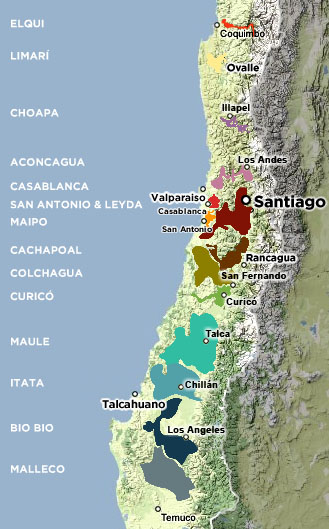 Chile is perhaps the farthest country from India, requiring over 24 hours of flying time to Santiago if one considers nominal waiting at 2-3 airports through which one has to travel. It may be difficult to imagine it would take around 6 hours to fly across from North to South within the same country- it is 4300 km long with a narrow average width of 177 kms (at some places it is as slim as 80 kms-including the mountain range) Chile is perhaps the farthest country from India, requiring over 24 hours of flying time to Santiago if one considers nominal waiting at 2-3 airports through which one has to travel. It may be difficult to imagine it would take around 6 hours to fly across from North to South within the same country- it is 4300 km long with a narrow average width of 177 kms (at some places it is as slim as 80 kms-including the mountain range)
With a population of around 16 million, it is less populated than Greater Delhi. Yet it cultivates around 105,000 hA (265,000 acres) of wine grapes. Its exports have been sky-rocketing since 1995 from $187 m to five fold in 10 years and crossed $1.1 billion last year. Despite the massive earthquake in February which set the country back by an estimated $20-30 billion and caused extensive damage to several wineries, there has been around 15% growth in exports during the first 5 months of this year as compared to last year; a significant achievement considering the world is still reeling under recession.
What makes it an interesting country for grape cultivation as the Conquistadores discovered it around 460 year ago and brought vines, is the diverse soil, an excellent climate due to the Andes Mountains being on the east and the Pacific Ocean on the west. With scores of rivers flowing from the mountains to the sea, several areas are provided the irrigation possibility due to the melting snow of the Andes.
A Country of Valleys
Additionally, there is the coastal mountain range between the Andes and the Ocean, dividing Chile into several valleys running from North to South. Maipo Valley was the oldest such valley where wine production had been centered. Over the years different sub-regions have been created and several valleys have come under vines and named in the DO appellation laws of Chile which are one of the most liberal in the wine world- formulated via Decree no. 464 of May 1995.
Maipo Valley may be the most popular valley for the lovers of Cabernet Sauvignon, the most predominant grape of Chile. The maximum cultivation of this varietal is in this valley-surrounding Santiago-with 6,172 hAs out of a total cultivar of about 11,700 hAs planted with this variety. Cousiño Macul, Haras de Pirque, El Principal, Concha y Toro, William Fevre, Chadwick, Almaviva, Carmen, Santa Rita, Antiyal, Pérez Cruz, Undurraga, Terramater, Canepa, Santa Ema, Tarapacá, De Martino, Odjfell, Baron Philippe de Rothschild are but a few of the wineries already in India or are very well-known internationally.
But Maule Valley, to the South of Santiago, with a cultivation of 31,800 hAs is the biggest vine growing area and most traditional area of Chile, known to produce predominantly red wines. Maule produces 75% red wines compared to Maipo which ferments even a higher percentage-84% as red wine- Cabernet Sauvignon being the most predominant red variety in both these areas.
Via Wines, Corral Victoria, Calina, Balduzzi, Cremaschi Furlotti, El Aromo, Julio Bouchon, Lomas de Cauquenes (co-operative) and Carta Vieja are some well known names some of which I visited or tasted their wines. Viñedos Puertas is a huge bulk wine producing facility that has been making some award winning wines lately.
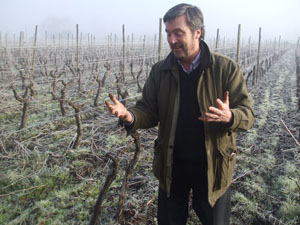 |
| Tipaume-Biodynamic Farm in Cachapoal |
Maipo, Rapel (divided into two-Cachapoal and Colchagua), Curicó and Maule Valleys are part of what is considered the Central Valley and most wines came from these four valleys till about 30 years ago when the expansion and experimentation started in a big way with foreign investment liberalized and the advent of a new area of technology with the arrival of Miguel Torres who came from Spain and set up base in Curicó in 1979 after General Pinochet dictated liberalization and allowed foreign participation. Earlier, the leftist regime of Allende had been quite regressive according to most established wine producers.
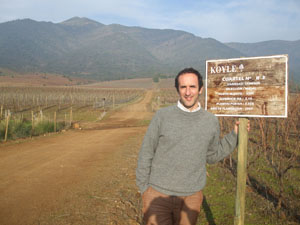 |
| Koyle Vineyards- Cachapoal |
San Pedro, Echeverría and Valdivieso are a few of the other wineries in Curico. Porta belonging to the Corporá group, La Ronciere, Camino Real, La Rosa, San Jose de Apalta, Anakena, Altaír from Cachapoal may be familiar to some of us. Colchagua has a host of known wineries that include Ravanal, Luis Felipe Edwards, Vie Manent, Casa Lapostolle, Neyén, Montes, Estampa, Montgras, Caliterra, Los Vascos, J F Lurton, Santa Cruz and Errazuriz Ovalle which was earlier imported by Sovereign Impex in India. Koyle is a relatively new winery well on its way to becoming an iconic name in the next decade.
Casablanca Valley, barely 70 kms away from Santiago and near the coast, is a relative new valley where the grape cultivation took off only in the eighties. The cool coastal climate of the valley may have made it world famous in a short time because of Sauvignon Blanc and Chardonnay, but the producers have been discovering diverse terroir within the Valley and even red grape varieties like Pinot Noir, Syrah are looking to have a higher share of the colour, currently having a share of 78% whites- making it the Valley of the whites along with San Antonio Valley to its South. Viña Casablanca owned by Santa Carolina, Quintay, Casas del Bosque, Morandé, Casa Marin, Veramonte, Kingston, Indómita, Viñamar and Leyda are some of the well known wineries of these two valleys.
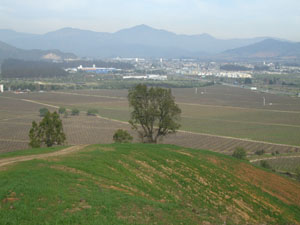 |
| Viña Casablanca owned by Santa Carolina- Casablanca Valley |
The valleys are generally named after the major rivers flowing through them-like Maipo River, Aconcagua River, and Maule River etc. Not all valleys are fortunate to have river water for irrigation. As Eduardo Brethauer, wine editor of Vitis- a popular Chilean wine magazine informs, ‘water shortage can be a big problem for many wineries. For instance Leyda in San Antonio Valley has acute water shortage. So a few wineries got together and built a pipeline from Maipo River.’
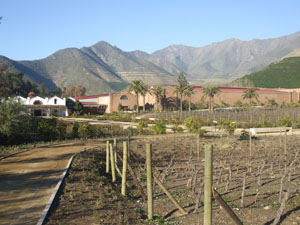 |
| Errazuriz Winery and Vineyards- Aconcagua Valley |
Another interesting valley to the north of Santiago is Aconcagua Valley which still has a limited number of high quality producers-like Errazuriz which was one of the first ones to have been in the region. Von Siebenthal which can claim to produce the most expensive wine in Chile is also located here, besides Arboleda, Seña (originally a JV between Chadwick of Errazuriz and Robert Mondavi).
New Valleys are being explored regularly adding to the acreage. Choapa Valley to the north is no more the last of the wine frontier. Limarí Valley is coming up fast, and some of the best Chardonnays come from here already. ‘Casa Tamaya was the first winery that produced interesting wines but later Tabali, Maycas del Limarí (owned by Concha y Toro) and a few others came up too and are producing excellent wines,’ adds Eduardo. In fact, several wineries are specialising now in wines from different valleys to offer the unique flavour of their terroir. Chilean laws allow bringing in grapes from a valley and bottling in their estate and labeling them as such..
Further to the north is the beautiful Elqui Valley which is under exploration-it is already known along with Limarí to grow grapes for Pisco- a grappa-like drink very popular with connoisseurs of cocktails, having a huge potential in India- yet untapped.
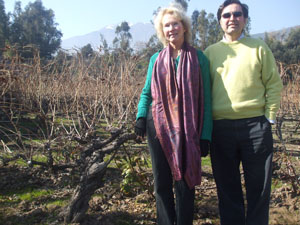 |
| Corcoran Gallery Winery vineyard- Alto Maipp valley |
The expansion is taking place fast in all directions- including in the foothills of Andes- known as the ‘Alto’ regions - like Alto Maipo, Alto Colchagua etc. Although about 70% of the wineries are located between Andes and the coastal mountain range, the new developments are taking place between the lator and the coast, some wineries being just a few kilometers from the sea, enjoying cool microclimate. Interestingly, the variations in climate in Chile are more from east to west, rather than north to south because of the mountain and the ocean. The winemaker at Quintay winery in Casa Blanca had us tank-taste five wines from the same clone of Sauvignon Blanc from different parts of Casablanca, each with a definite and diverse personality-thus offering an opportunity to blend and create infinite flavours. About a decade ago, one heard of the up-coming Bío Bío Valley – the southernmost frontier for the grape growers. Today it has become the center of the valleys-south of the Central Valley. Located to the south of Maule, with Itata Valley to its North, it already has Malleco Valley to its South.
The exploration and experimentation by the wine apassionatos continues towards the Antarctic though the last of the frontiers seem to be close now. However, it is difficult to say where this journey would stop; it was only 30 years ago that Casablanca was considered a poor area for grapes! Christian Sotomayor, owner of Valdivieso is already experimenting in Osorno, 826 kms south of Santiago and too far below the existing maps of the valleys in Chile. In a small vineyard of around a hectare he is growing Chardonnay, Pinot Noir, Pinot Meunier and a small amount of Sauvignon Blanc to produce a sparkling wine which has a unique character, according to Eduardo. If the experiment is successful, there may be hordes of producers running (actually flying) to it to try the terroir for their wines.
Grapes of Chile
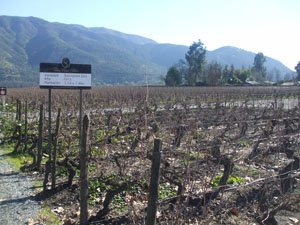 |
| Sauvignon Gris Vineyard of Casa Silva-planted 1912 |
Thinking of a good Chilean wine brings immediately the image of Cabernet Sauvignon, the most widely grown red variety. Other popular varieties include the signature Carménère, a difficult grape to grow for fine wine- and though I have been a great proponent of promoting this as the signature grape of Chile for over a decade, it is only in the last few years that wineries like Montes, Casa Silva and De Martino have helped make the wine with this varietal quite sought after, within and outside Chile.
Merlot, Pinot Noir, Syrah, Malbec (known as Cot in Chile), Cabernet Franc, Petit Verdot and Tempranillo are other reds. There has been a recent revival of Carignan as a blend or even varietal getting more popular and the price of the grapes have shot up over 10 times during the last 15 years or so. Pais as the native
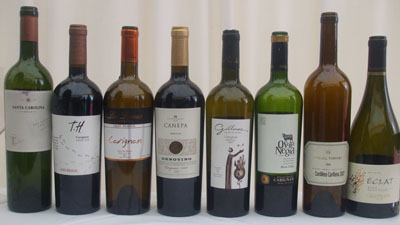 |
| Some Members of the Carignan Club |
grape is still on the top of the charts for many growers but is fast losing its charm with the growing international market not keen on this varietal. Although over 100 year old vines of this varietal are quite common, there are frequent uprootings and replantings into other red varietals. At around 29,000 hAs planting; whites are still a minority with 27% share with Sauvignon Blanc, Chardonnay, Viognier and some Sauvignon Gris being the predominant varietals.
One is all too familiar with the discovery a couple of decades ago that Sauvignon was actually another cheaper variety called Sauvignasse (like Tocai Friulano grape in Italy, the name of which has been banned from use now). Similar confusion exists between Merlot and Carmenere which has been mistaken as Merlot and despite claims to the contrary, around 30% of the registered Merlot crop in Chile is still Carmenere.
Passion for Terroir
It may be due to the influence of the French winemakers who came looking for survival after the Phylloxera hit their native land over a century ago, but Chileans are more passionate about terroir than most New World countries, except perhaps South Africa. Further sub-divisions of valleys are imminent because of this passion. Many are already using names like Alto and Coastal etc. The law requires a minimum of 85% grapes for a particular varietal. Similarly, only 85 % of the grapes need be from the valley it for the nomenclature.
The wide range of bulk wines, which went up in prices by around 30% this year due to the earthquake, may make the selection of wines for imports from Chile difficult because of the big spectrum of quality. But the range of fine wines at affordable prices makes the import of their bottled wines a challenge and an opportunity to pick up some fantastic deals.
And of course, who is there to prevent an importer to get wines bottled with their private labels or even buy the wineries in toto. Casa Lapostolle, Calina, Lurton, Miguel Torres are a few of the wineries owned completely by foreigners and who knows-one day Indians might be looking for such an opportunity- there is still plenty of vineland available at affordable prices-much cheaper than Nashik, anyway.
Subhash Arora
Here are the valleys and the wineries I visited during my visit as a jurado (juror) at the Grand Hyatt Catad’Or wine competition. Besides, we tasted wines from over 30 more wineries during lunches and dinners. Watch out for this space for details in the future editions. For a list of some of the Chilean dolls, click HERE
| Winery |
|
Valley |
| Viñedos Puertas |
|
Maule |
| Via Wines |
|
Maule |
| Casa Silva |
|
Colchagua |
| Miguel Torres |
|
Curico |
| Errazuriz |
|
Aconcagua |
| Viña Casablanca |
|
Casablanca |
| Viña Quintay |
|
Casablanca |
| De Martino |
|
Maipo |
| Perez Cruz |
|
Maipo |
| La Ronciere |
|
Cachapoal |
| Corpora |
|
Cachapoal |
| Tipaume |
|
Cachapoal |
| San Jose de Apalta |
|
Cachapoal |
| Viña Koyle |
|
Colchagua |
| Viña La Rosa |
|
Cachapoal |
| Casa Lapostolle Apalta |
|
Colchagua |
| Montes Apalta |
|
Colchagua |
| Corcoran Gallery Winery |
|
Maipo |
|